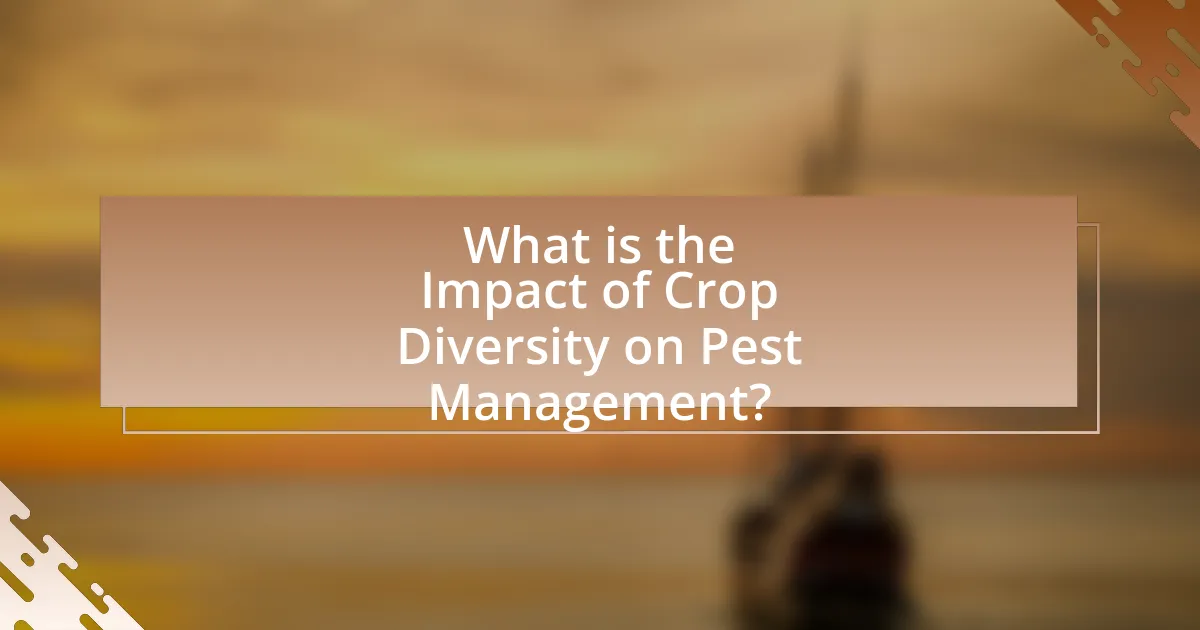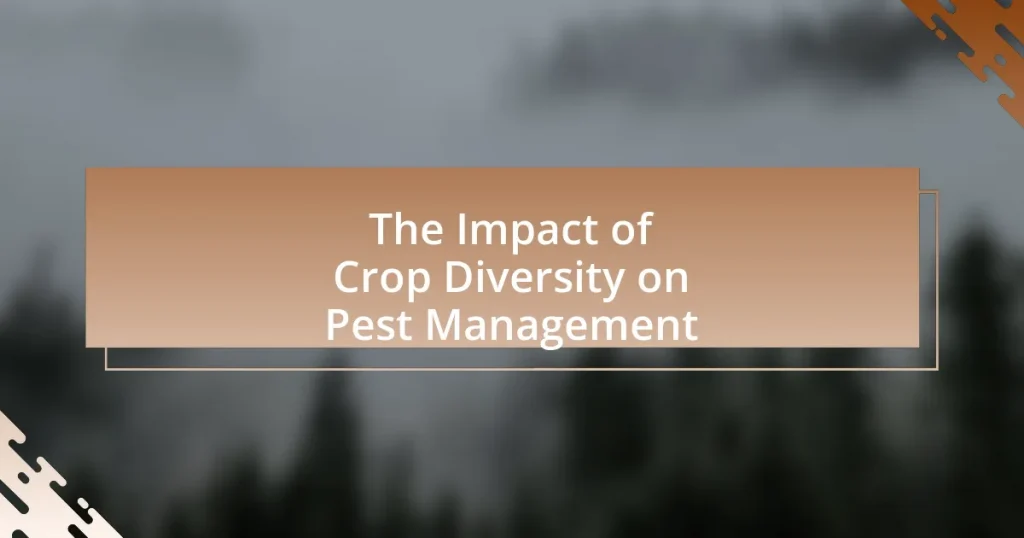The article examines the impact of crop diversity on pest management, highlighting its role in enhancing ecological balance and reducing pest populations. It discusses how diverse cropping systems create habitats for beneficial organisms that naturally control pests, leading to significant reductions in pest incidence, with studies indicating up to a 50% decrease in pest damage compared to monocultures. The article also explores the mechanisms of pest suppression through habitat diversification, the influence of crop diversity on pest behavior and life cycles, and the ecological benefits of promoting beneficial organisms. Additionally, it addresses the challenges and economic implications of implementing crop diversity in agricultural practices, while providing practical steps for farmers to integrate these strategies into their pest management plans.

What is the Impact of Crop Diversity on Pest Management?
Crop diversity significantly enhances pest management by promoting ecological balance and reducing pest populations. Diverse cropping systems create habitats for beneficial organisms, such as predators and parasitoids, which naturally control pest populations. Research indicates that farms with higher crop diversity experience lower pest incidence; for example, a study published in the journal “Agriculture, Ecosystems & Environment” found that polycultures can reduce pest damage by up to 50% compared to monocultures. This reduction occurs because diverse crops disrupt pest life cycles and provide alternative food sources for natural enemies, leading to more effective pest suppression.
How does crop diversity influence pest populations?
Crop diversity significantly influences pest populations by disrupting their life cycles and reducing their abundance. When multiple crop species are grown together, it creates a more complex habitat that can support a wider range of natural enemies, such as predators and parasitoids, which help control pest populations. Research indicates that diverse cropping systems can lower pest density by up to 50% compared to monocultures, as pests are less likely to find their preferred host plants. Additionally, crop diversity can enhance ecosystem resilience, making it harder for pests to establish and proliferate.
What mechanisms are involved in pest suppression through crop diversity?
Crop diversity suppresses pests through several mechanisms, including habitat diversification, enhanced natural enemy populations, and reduced pest establishment. Habitat diversification occurs as varied crops create microhabitats that support beneficial organisms, which can prey on pests. Enhanced natural enemy populations arise because diverse cropping systems attract a wider range of predators and parasitoids, leading to increased biological control. Additionally, reduced pest establishment is facilitated by crop rotation and intercropping, which disrupt pest life cycles and diminish their ability to thrive. Studies have shown that farms with higher crop diversity experience lower pest densities, demonstrating the effectiveness of these mechanisms in pest management.
How does crop diversity affect pest behavior and life cycles?
Crop diversity significantly influences pest behavior and life cycles by disrupting pest populations and their reproductive patterns. When multiple crop species are cultivated in proximity, it creates a less favorable environment for specific pests that thrive on monocultures. Research indicates that diverse cropping systems can reduce pest abundance by providing habitats for natural predators and parasitoids, which help control pest populations. For instance, a study published in the journal “Agriculture, Ecosystems & Environment” by Landis et al. (2000) found that increased plant diversity led to a 50% reduction in pest density compared to monocultures. This reduction in pest populations can alter their life cycles, as fewer resources lead to decreased reproduction rates and slower development times. Thus, crop diversity serves as a crucial strategy in integrated pest management by enhancing ecological balance and reducing reliance on chemical pesticides.
What are the ecological benefits of crop diversity in pest management?
Crop diversity in pest management enhances ecological resilience by promoting beneficial interactions among various plant species and their associated pests and predators. This diversity disrupts pest life cycles and reduces the likelihood of pest outbreaks, as a varied crop environment can support a wider range of natural enemies, such as predators and parasitoids. Research indicates that polycultures can lead to a 50% reduction in pest populations compared to monocultures, as demonstrated in studies by the University of California, Davis, which found that diverse cropping systems can significantly lower pest incidence and improve overall crop health.
How does crop diversity enhance ecosystem resilience against pests?
Crop diversity enhances ecosystem resilience against pests by creating a more complex habitat that supports a variety of beneficial organisms. This complexity disrupts pest populations by providing natural predators and parasitoids with diverse food sources and habitats, which can effectively control pest numbers. Research indicates that fields with higher crop diversity can reduce pest outbreaks by up to 50%, as seen in studies conducted by the University of California, which demonstrated that polycultures significantly lower pest incidence compared to monocultures. Thus, increased crop diversity not only promotes ecological balance but also contributes to sustainable pest management strategies.
What role does crop diversity play in promoting beneficial organisms?
Crop diversity plays a crucial role in promoting beneficial organisms by creating a more complex and varied habitat that supports a wider range of species. This increased habitat complexity enhances the availability of resources such as food and shelter, which in turn attracts beneficial organisms like pollinators and natural pest predators. Research indicates that diverse cropping systems can lead to higher populations of beneficial insects, which are essential for pest control and pollination. For instance, a study published in the journal “Agriculture, Ecosystems & Environment” found that farms with greater crop diversity had significantly higher numbers of predatory insects, demonstrating the direct link between crop variety and the abundance of beneficial organisms.
What challenges are associated with implementing crop diversity for pest management?
Implementing crop diversity for pest management faces several challenges, including the complexity of managing diverse cropping systems and the potential for increased pest pressure. The introduction of multiple crop species can complicate pest monitoring and control strategies, as different crops may attract various pests, making it difficult to predict pest dynamics. Additionally, farmers may experience economic constraints, as transitioning to diverse cropping systems often requires investment in new seeds, equipment, and knowledge. Research indicates that while crop diversity can enhance resilience against pests, the initial costs and the need for specialized management practices can deter adoption among farmers (Tilman et al., 2017, Proceedings of the National Academy of Sciences).
What are the economic implications of adopting diverse cropping systems?
Adopting diverse cropping systems leads to enhanced economic resilience for farmers. This resilience is achieved through increased yield stability, reduced pest and disease pressure, and improved soil health, which collectively lower production costs. For instance, studies have shown that crop diversification can reduce the need for chemical inputs by up to 30%, directly impacting profitability. Additionally, diverse cropping systems can open new markets and increase overall farm income by allowing farmers to produce a variety of crops that cater to different consumer demands.
How can farmers overcome barriers to increasing crop diversity?
Farmers can overcome barriers to increasing crop diversity by implementing crop rotation, intercropping, and utilizing cover crops. These practices enhance soil health, reduce pest populations, and improve resilience against diseases. For instance, research shows that crop rotation can decrease pest incidence by disrupting their life cycles, leading to a 30% reduction in pest populations in some cases. Additionally, intercropping can create a more complex habitat that attracts beneficial insects, further aiding pest management. By adopting these strategies, farmers can effectively enhance crop diversity while simultaneously managing pests.
How can crop diversity be effectively integrated into pest management strategies?
Crop diversity can be effectively integrated into pest management strategies by utilizing a combination of polyculture, crop rotation, and intercropping techniques. These methods enhance ecosystem resilience, disrupt pest life cycles, and promote beneficial organisms. For instance, studies have shown that polyculture systems can reduce pest populations by up to 50% compared to monocultures, as diverse plant species can attract natural predators and parasitoids that control pest populations. Additionally, crop rotation prevents the buildup of specific pests and diseases associated with single crops, while intercropping can create a more complex habitat that deters pests. This integration of crop diversity into pest management not only minimizes chemical pesticide use but also supports sustainable agricultural practices.
What specific practices can enhance crop diversity for better pest control?
Implementing crop rotation, intercropping, and cover cropping are specific practices that can enhance crop diversity for better pest control. Crop rotation involves alternating different crops in the same area across seasons, which disrupts pest life cycles and reduces their populations. Intercropping, the practice of growing two or more crops in proximity, can create a more complex habitat that attracts beneficial insects and deters pests. Cover cropping, which involves planting crops that are not intended for harvest, can improve soil health and provide habitat for natural pest predators. Research indicates that farms employing these practices experience lower pest incidence and increased yields, demonstrating the effectiveness of crop diversity in pest management.
How can intercropping and crop rotation be utilized for pest management?
Intercropping and crop rotation can be utilized for pest management by disrupting pest life cycles and enhancing biodiversity. Intercropping involves planting different crops in proximity, which can confuse pests and reduce their populations by attracting natural predators. For example, planting legumes alongside cereals can deter aphids, as the legumes attract beneficial insects. Crop rotation, on the other hand, involves changing the type of crop grown in a particular area each season, which interrupts the habitat and food sources for pests that are specific to certain crops. Research has shown that rotating crops can reduce pest populations by up to 50%, as pests struggle to adapt to the changing environment. Together, these practices enhance ecosystem resilience and promote natural pest control mechanisms.
What are the best practices for selecting crops to maximize diversity benefits?
To maximize diversity benefits in crop selection, farmers should implement polyculture systems that incorporate a variety of species and cultivars. This practice enhances ecosystem resilience, reduces pest outbreaks, and improves soil health. Research indicates that diverse cropping systems can lead to a 20-50% reduction in pest populations compared to monocultures, as seen in studies conducted by the University of California, Davis, which highlight the role of biodiversity in pest suppression. Additionally, selecting crops that complement each other in nutrient uptake and growth patterns can further enhance productivity and sustainability.
What future research is needed to understand the impact of crop diversity on pest management?
Future research needed to understand the impact of crop diversity on pest management includes studies that quantify the relationship between crop diversity and pest population dynamics. Specifically, research should focus on how varying levels of crop diversity influence pest resistance and resilience in agricultural ecosystems. For instance, experiments that manipulate crop diversity in controlled environments can provide insights into pest behavior and interactions. Additionally, long-term field studies are essential to assess the sustainability of pest management strategies that leverage crop diversity, as evidenced by findings from the International Journal of Pest Management, which highlight the role of diverse cropping systems in reducing pest outbreaks.
What practical steps can farmers take to implement crop diversity in their pest management plans?
Farmers can implement crop diversity in their pest management plans by rotating different crops, intercropping, and utilizing cover crops. Crop rotation disrupts pest life cycles, reducing their populations and minimizing damage; for example, alternating between legumes and cereals can enhance soil health and deter specific pests. Intercropping, or planting multiple crops in proximity, can create a more complex habitat that attracts beneficial insects, which help control pest populations. Additionally, cover crops can improve soil structure and fertility while providing habitat for natural pest predators. Research indicates that farms practicing diverse cropping systems experience lower pest incidence and increased resilience against pest outbreaks, demonstrating the effectiveness of these strategies in sustainable agriculture.










